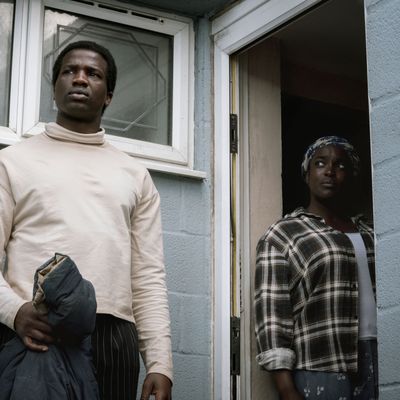
ÔÇ£To find the scariest monster we need look no further than the human demon.ÔÇØ That was how Jordan Peele described the concept of the ÔÇ£social thrillerÔÇØ in the run-up to the early 2017 release of Get Out, which now feels like a watershed moment. The horror genre has, to be fair, always had a social and moral dimension to it, even when the connections havenÔÇÖt been overt; that ÔÇ£torture pornÔÇØ came to prominence during the dark days of the Iraq War was no coincidence. But over the past several years, perhaps understandably, horror seems to have become a primary vernacular through which many filmmakers have processed the grim realities of our world. That hasnÔÇÖt always been to the picturesÔÇÖ benefit, as we saw in September with the release of the much-loathed Antebellum. (Be sure to read Angelica Jade Basti├®n and Alison WillmoreÔÇÖs excellent pieces on that and other filmsÔÇÖ desperate attempts ÔÇö and ultimate failures ÔÇö to speak to ÔÇ£the moment.ÔÇØ)
It helps, however, if the movie in question is scary as fuck. For all its topicality, Remi WeekesÔÇÖs His House, which premiered at Sundance earlier this year and is now being released on Netflix, works first as an inventive, stone-cold, cover-your-eyes chiller. ItÔÇÖs a haunted house flick, only the setting isnÔÇÖt some moody, gray old manse but a run-down row house in a bleak, impoverished English suburb, where Bol (Gangs of LondonÔÇÖs ß╣óß╗ìpß║╣ D├¼r├¡s├╣) and his wife, Rial (Lovecraft CountryÔÇÖs Wunmi Mosaku), have just arrived from South Sudan, penniless and shell-shocked. Lost during their perilous journey, we learn, was their daughter. A refugee nonprofit sets the couple up in a new home ÔÇö the social worker helping them notes that their place is bigger than his ÔÇö and pretty much leaves them to figure the rest out on their own. ÔÇ£Make it easy for people. Be one of the good ones,ÔÇØ theyÔÇÖre told. So what if there are flies and maggots all over their new house? And so what if thereÔÇÖs a demon lurking within its walls?
Pretty quickly, mysterious holes emerge. Unseen footsteps thunder ÔÇö thump-thump-thumpthumpthumpTHUMP. Husband and wife have sudden, ghostly visions of their treacherous ocean crossing. It would have been easy to turn these into standard-issue jump scares, but Weekes consistently finds new ways to present familiar devices. So we get the whole frightening-figure-suddenly-emerging-behind-our-hero thing, but itÔÇÖs done in such a way that you never expect it. The director even manages to give a new spin to the usual interplay between now-you-see-it darkness and wait-where-did-it-go light. What a relief it is in this day and age to watch a horror movie where the filmmakers have given as much thought to what will scare the viewer as to What It All Means.
ThatÔÇÖs not to say, however, that the social dimension has taken a back seat. The terrors of His House have been interwoven with the terrors of the refugee experience, which lends the story emotional depth and also ensures that its shocks linger, disturbingly, with little relief or closure. The differences in temperament between husband and wife are telling: Bol pursues the sounds, looks in the holes, determined to confront whatÔÇÖs there; he wants to make this house his. Rial, on the other hand, seems resigned to the fact that something is haunting them and wonÔÇÖt let go; she believes they have been cursed. ÔÇ£An apeth has risen from the ocean,ÔÇØ she tells her husband matter-of-factly, using the Dinka word for witch. ÔÇ£It has followed us here.ÔÇØ Their harrowing journey across the water ÔÇö where they lost their daughter ÔÇö keeps returning as a central image of trauma. Appropriate, but also a clever bit of misdirection from Weekes: The real horror, we eventually learn, runs deeper, and reaches farther back. (Yes, IÔÇÖve probably already said too much.)
Weekes and his cast get the little things right, which in turn allow the big things to work. Early on, we see the warmth and ease between Bol and Rial, which gives their eventual alienation from one another a tragic quality. The delicacy with which Bol touches the walls of their new house ÔÇö despite the fact that the place is a decaying trash heap ÔÇö conveys the care he hopes to give to it, as well as his fear of upsetting the gentle balance of this new life. Also, their strange new milieu is often scary enough without any assistance from ancient witches. Lost in a desolate, mazelike corner of the neighborhood one day, Rial asks for directions from a group of teens, only to be mocked and told to ÔÇ£go back to Africa.ÔÇØ That the kids themselves are Black just adds to her sense of disorientation and fear.
But eventually, it all feeds into these two individualsÔÇÖ own conceptions of where and how they fit into the world, and whether they can reconcile their past with their present. The story arcs not toward clarity but toward complexity and gnawing discomfort; the more we learn about Bol and Rial, the more complicated and human they become, and the messier and more ghastly their past becomes. Horror is often cathartic, purifying ÔÇö it puts you through the wringer but you emerge on the other side, somehow cleansed. YouÔÇÖll find no such succor here. His House is beautifully made, and its scares are monstrously effective, but its images of real-world dread remain unresolved, its specters unvanquished. The film leaves you with wounds that wonÔÇÖt heal.
More Movie Reviews
- Flow Is an Animal Adventure ThatÔÇÖs Endearing and a Little Too Pretty
- Alien: Romulus Gets the Job Done, But at What Cost?
- Blitz Is the Worst Movie Steve McQueen Has Made


